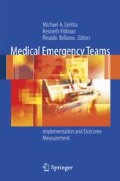Access this chapter
Tax calculation will be finalised at checkout
Purchases are for personal use only
Preview
Unable to display preview. Download preview PDF.
References
Dyer C. Bristol doctors found guilty of serious professional misconduct. BMJ. 1998;316:1924.
Brennan TA, Leape LL, Laird NM, Hebert L, Localio AR, Lawthers AG. Incidence of adverse events and negligence in hospitalized patients: results of the Harvard Medical Practice Study I. N Engl J Med. 1991;324:370–376.
Leape LL, Brennan TA, Laird NM, et al. Nature of adverse events in hospitalized patients: results of the Harvard Medical Practice Study II. N Engl J Med. 1991;324:377–384.
Wilson RM, Runciman WB, Gibberd RW, Harrison BT, Newby L, Hamilton JD. The Quality in Australian Health Care study. Med J Aust. 1995;163:458–471.
David P, Lay-Yee R, Briant R, et al. Adverse events in New Zealand public hospitals I: occurrence and impact. N Z Med J. 2002;115:U271.
Davis P, Lay-Yee R, Briant R, et al. Adverse events in New Zealand public hospitals II: occurrence and impact. N Z Med J. 2003;116:U624.
Department of Health. An organization with a memory: report of an expert group on learning from adverse events in the NHS chaired by the Chief Medical Officer. Crownright. Department of Health, HMSO. 2000.
Schioler T, Lipezak H, Pedersen BL, et al. Danish adverse events study. Incidence of adverse events in hospitals. A retrospective study of medical records. Ugeskr laeger. 2001;163:5370–5878.
Baker GR, Norton PG, Flintolf V, et al. The Canadian adverse events study: the incidence of adverse events among hospital patients in Canada. CMAJ. 2004;179:1678–1686.
McQuillan P, Pilkington S, Allan A, et al. Confidential inquiry into quality of care before admission to intensive care. BMJ. 1998;316:1853–1858.
Goldhill DR, White SA, Sumner A. Physiological values and procedures in the 24 hours before ICU admission from the ward. Anaesthesia. 1999;45:529–534.
Thomas EJ, Studdert DM, Runciman WB, et al. A comparison of iatrogenic injury studies in Australia and the United States I: context, method, casemix, population, patient and hospital characteristics. Int J Q Health Care. 2000;12:371–378.
World Health Organization. Progress in essential drugs and medicine policy 1998–1999. WHO/EDM/2000.2: 2000.
Kohn LT, Corrigan JM, Donaldson MS, eds. To Err Is Human: Building a Safer Health System. Washington, DC: National Academies Press; 2000.
Lee A, Bishop G, Hillman K, Daffurn K. The Medical Emergency Team. Anaesth Intensive Care. 1995;23:183–186.
Hourihan F, Bishop G, Hillman KM, Daffurn K, Lee A. The medical emergency team: a new strategy to identify and intervene in high-risk patients. Clin Intensive Care. 1995;6:269–272.
World Health Organization. World Alliance for Patient Safety. Forward program 2005. France: WHO; 2005.
McGlynn E, Brook RH. Keeping quality on the policy agenda. Health Aff. 2001;20(3):82–90.
Becher EC, Chassin MR. Improving quality, minimizing error: making it happen. Health Aff. 2001;20:68–82.
Hillman K, Alexandrou E, Flabouris M, et al. Clinical outcome indicators in acute hospital medicine. Clin Intensive Care. 2000;11:89–94.
Author information
Authors and Affiliations
Editor information
Editors and Affiliations
Rights and permissions
Copyright information
© 2006 Springer Science+Business Media, Inc.
About this chapter
Cite this chapter
Young, L., Chen, J., Hillman, K. (2006). Information Systems Considerations: Integration of Medical Emergency Team Clinical Indicators. In: DeVita, M.A., Hillman, K., Bellomo, R. (eds) Medical Emergency Teams. Springer, New York, NY. https://doi.org/10.1007/0-387-27921-0_22
Download citation
DOI: https://doi.org/10.1007/0-387-27921-0_22
Publisher Name: Springer, New York, NY
Print ISBN: 978-0-387-27920-6
Online ISBN: 978-0-387-27921-3
eBook Packages: MedicineMedicine (R0)

